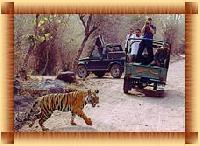
Wild India
Duration : 14 Nights 15 DaysDestinations : Ranthambhore - Kanha - Gir - New Delhi - CorbettDay 01 : RanthambhoreWelcome to India! You will be received at the international airport and will be transferred straight to Ranthambhore National Park in your excusive vehicle. On arrival check in at your jungle resort. Further move out for a wild life safari inside the National Park. Day 02 : RanthambhoreMove out for a jungle safari in open jeep to watch the Royal Bengal Tiger in its natural habitat. After lunch again take the safari to explore what you missed in the previous safaris.Day 03 : RanthambhoreIn the morning move out for a jungle safari for wild life viewing. In the evening you will be transferred to the Agra to board the train for Jabalpur. Over night in your AC train coach. Day 04 : KanhaOn arrival at Jabalpur, drive to Kanha National Park in your exclusive vehicle. On arrival check in at your jungle resort. Further move out for a jungle safari to take the Royal Bengal Tiger one on one. Rest of the time free at leisure. Day 05 : KanhaMove out for a jungle safari in open jeep to watch the Royal Bengal Tiger in its natural habitat. After lunch we again take the safari to explore what we missed in the previous safaris. Day 06 : KanhaMove out for a jungle safari in open jeep to watch the Royal Bengal Tiger in its natural habitat. After lunch again take the safari to explore what you missed in the previous safaris.Day 07 : Overnight in trainIn the morning drive to Jabalpur to board the train for Rajkot. Over night in your AC train coach. Day 08 : GirOn arrival you will be received at the train station and will be transferred to the Gir wildlife park. On arrival check in to your jungle resort. Rest of the time free for leisure. Day 09 : GirIn the morning move out to watch the Asiatic Loin in its natural habitats. After lunch again take a jungle safari to explore what you missed in first one. Rest of the time free for leisure.Day 10 : GirMorning and the evening jungle safari in the national park. Day 11 : Night in the trainAt appropriate time you will be transferred to the Rajkot airport to board the connecting flight for New Delhi. On arrival at New Delhi you will received and transferred to your hotel. Rest of the day at leisure. In the evening you will be transferred to the train station to board the train for Ramnagar. Over night at your AC train coach. Day 12 : CorbettOn arrival you will be transferred straight to your hotel. Relax for a while. Move out for an elephant safari for wild life viewing. Overnight at your jungle resort.Day 13 : CorbettIn the morning drive to Kaladungi (a beautiful place for bird watching). Rest of the time free for leisure. Day 14 : Overnight in trainIn the morning move out for an open jeep safari to watch the Royal Bengal Tigers in there natural habitats. After lunch again take an elephant safari to explore what you missed in first two. Return to your hotel. Relax for a while. You will be transferred to the train station to board the train for New Delhi. Day 15 : DepartureOn arrival you will be transferred to the international airport to board the flight for further journey back to home the tour ends.
...more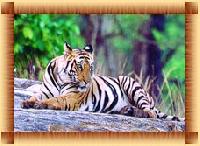
Weekend with Royal Bengal Tiger
Duration : 02 Nights 03 DaysDestinations : BandhavgarhDay 01 : Bandhavgarh National Park (Over night Train Journey)Welcome to India. You will be received at the international airport and assisted towards the train station to board a train to Umaria. The train will depart from New Delhi at 12:50 and reach at 08:50 in the morning. At the Umaria train station you will be received and assisted to your wild life resort and check in. After having lunch move out for a open jeep safari in inside the park for wildlife viewing. Overnight in the resort.Day 02 : Bandhavgarh National ParkAfter a leisurely breakfast take a Elephant Safari to watch the Royal Bengal Tiger in there natural habitat. You can also enjoy a good wild photography on your 3 hour long trip to Bandhavgarh National Park. After lunch we again take the safari to explore what we missed in the first one. Overnight stay in the resort Day 03 : Bandhavgarh - Delhi (Onward Destination)Early morning elephant safari in the park. After a leisurely lunch we board a train Which depart at 17:55 and arrives at New Delhi 13:30. On arrival you will be received and assisted towards the international airport to board the flight to home, the tour ends.
...more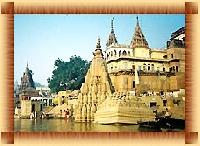
Varanasi tour services
Varanasi, the eternal city is one of the most important pilgrimage sites in India & also a major tourist attraction. Situated on the bank of sacred Gangas, Varanasi has been a centre of learning & civilization for over 2000 years. It was at Sarnath only 10 km away that the Buddha first preached his message of enlightenment, 25 centuries ago. Later the city became the great Hindu centre, but was looted a number of times by the Muslims invaders from the 11th century on. Varanisi has also been known as the Kashi & Banaras, but its present name meaning the city between the two rivers - the Varauana & Asi For the pious Hindu the city has always had a special place. Besides being a pilgrimage centre, it is considered an auspicious place to die, ensuring an instant route to heaven. The popularity of Varanasi can be counted for many other reasons, for it is the oldest living city of the world. For some it can be a source of purification, for many others it is dirtiest urban mess they have ever seen. For some its festivities inspire celebration of life yet for some others its celebrated funeral ceremonies invite perplexed reactions. The strange rituals may seem fascinating to many, the same practices seem orthodox or sometimes inhuman to others. For many its spiritually charged atmosphere is enlightening, yet at the same time its dirt is disgusting. Love it or hate it, Varanasi is one city that fails to leave any visitor unaffected by its overwhelming identity. Ghats : Principal attraction of Varanasi is the long strings of bathing ghats which lines the west bank of Ganges. Ghats are the steps which lead down to the river, & where, at the two burning ghats, bodies are cremated. The best time to visit the ghats is at dawn when pilgrims take their early morning dip the city is coming alive, the light is magical & Varanasi is an exotic place. Great Mosque of Aurangzeb : Constructed using columns from the biseswar Temple razed by Aurangzeb, this great mosque has minarets towering 71 meters above the Ganges. Armed guards protect the mosque as the Indian government wants to ensure there are problems between Hindus & Muslims. Durga Temple : Durga Temple is commonly known as the monkey temple due to the many monkeys that have made it their home. It was built in the 18th century by the Bengali maharani & is stained red with ochre. The small temple is built in north Indian Nagara style with muiltitiered sikhara. Tulsi Manas Temple : Next to the Durga temple this modern marble sikhara- style temple. Built in 1964, wall the of temple are engraved with verses & scenes from the Ram Charit Manas, the Hindi version of the Ramayana. On the second floor you can watch the production of moving & performing statues & scenes from the Hindu mythology. New Vishwanath Temple : The new Vishwanath temple which was planned by Pandit Malaviya & built by the wealthy Birla family of industrialists. The interior has a Siva lingam & verses from Hindu scriptures inscribed on the walls. The temple is supposed to be the replica of the original Vishwanath Temple, destroyed by Aurangzeb.RAM NAGAR FORT & MUSEUM- On the other side of the river, this 17th century fort is the home of the Maharaja of Benaras. There are tours to the fort or you can catch a ferry across the river to get to it. The interesting museum contains old silver & brocades, a replica of the royal bed & an armory of swords & old guns. Helping Facts: Airport : Varanasi has it own major airport of the region with connection even to Nepal & most of the important cities. Railways : The railway station is well served. Mughalsarai station nearby is the busiest railway junction in India. Roadways : Oldest working highway Grand Trunk Road of India passes through Varanasi. And it is also having its connection with the nearest points like Kushinagar, Patna, Kathmandu and Khajuraho. Important information- There may be sadhus who may try to take advantage of your unawareness about the place. Take care of your belongings and never fall in the trap of forced religious donations. Do not take pictures of Sadhus without their permission. Take care of the religious sensitiveness of the place. Climate : In the summer season Varanasi is hot & in the winter season it is much cooler & temperature decreases around 250C to 300C. Tour to Varanasi Indian Temples Duration : 10 Nights 11 DaysDestinations : Udaipur - Ranakpur - Jodhpur - Jaipur - Agra - Khajuraho - Varanasi - Delhi - RishikeshBuddha Calling Duration : 09 Nights 10 DaysDestinations : Kolkata - Gaya - Varanasi - Allahabad - Lucknow - GorakhpurGlory of India Duration : 20 Nights 21 DaysDestinations : Kolkata - Kaziranga - Darjeeling - Gangtok - Varanasi - Khajuraho - Bandhavgarh - Agra - Ranthambhore - Jaipur - New Delhi
...more
Udaipur tour services
Udaipur the city situated in the state of desert Rajasthan & although it is popularly known as the lake city. Possibly there is no city as romantic as Udaipur in the whole Rajasthan. The French Impressionist painters, let alone the Brothers Grimm, would have loved this place. It is not without justification that Udaipur has been called the Venice of the east, & the old city is a jumble of tangled streets. The Mewar festival is the biggest festival celebrated in Udaipur. It is a great time to be in the town, with the women of Udaipur dressing up in their finest. It mostly be celebrated in the month of April or in the last week of the March month. Lake Pichola : This lake was enlarged by Maharaja Udai Singh II & the lake is 4km in length & it is 3km wide. The City Palace extends a considerable distance along the east bank of the lake. North of the palace you can wonder along the lakeshore, where there are some interesting bathing & dhobi ( laundry ) ghats. Jag Niwas Island : Jagniwas, the lake Palace island, is about 1.5 hectares in size. The place was built by Maharaja Jagat Singh II in 1754 & covers the whole island. It is one of the greatest tourist attraction & also liked by the tourists for its beautiful sceneries & memorable sunsets. City Palace & Museums : The City Palace is the largest palace complex in the Rajasthan. The palace is surmounted by balconies, towers & cupolas & there are fine views over the lake & the city from the upper terraces. The main part of the Palace is now preserved as a museum. It includes the Mor (Peacock) Chowk with its beautiful mosaic of peacocks, the favorite Rajasthani bird. The Manak Mahal (Ruby Mahal) has glasswork & mirror work, while Krishna Vilas has a remarkable collection of miniatures (photography is not allowed). In the Bari Mahal, there is a pleasant central garden. The Moti Mahal has beautiful mirror work & the Chini Mahal is covered in ornamental tiles. There is a crystal gallery at the Fateh Prakash Palace Hotel in the City Palace complex. This rare collection of crystal chairs of Osler, tables, & even beds! Jagdish Temple : Only 150m north of the entrance to the City Palace, this fine Indo- Aryan temple was built by Maharaja Jagat Singh in 1651 & enshrines a black stone image of the Garuda in a shrine in front of the temple. Fatheh Sagar : North of the lake Pichola, this lake is overlooked by a number of hills & is a popular hang-out for young lovers. It was originally built in 1678 by Maharaja Jai Singh. In the middle of the lake is Nehru Park, a garden island with a boat shaped cafe. Saheliyon- ki- Bari : Saheliyon-ki-Bari, or garden of the Maids of Honour, is in the north of the city. This ornamental garden, with its fountains, kiosks, marble elephants & delightful lotus pool. Sajjan Gahr (Monsoon Palace) : On a distant mountain range, this neglected palace was constructed by Maharaja Sajjan Singh in the late 19th century. It is now owned by the government, the main reason to come here is to see the absolutely breathing views, particularly at sunset. Helping Facts: Airways : Udaipur has its own domestic airport which connects the city from all the major cities across the country. Railways : Udaipur is having its railway station from where one can travel to any corner of India. Roadways : Udaipur connects itself to the cities within Rajasthan & the near to the Rajasthan i.e. Delhi, Harayana, Gujarat, & Punjab. Climate : In summer the temperature goes up to 400C to 450C & winters are much pleasant over ere the temperature goes down up to 120C to 170C. Further Connection : Jaipur, Udaipur, Jodhpur, Deogarh, Delhi, Ajmer and Mumbai. Tour to Udaipur Shoppers Stop Duration : 15 Nights 16 DaysDestinations : Delhi - Jaipur - Deogarh - Udaipur - Jodhpur - Samode - Ranthambhore - AgraClassic India Duration : 13 Nights 14 DaysDestinations : New Delhi - Agra - Ranthambhore - Jaipur - Deogarh - Udaipur - Jodhpur - SamodeKingdom of Rajasthan Duration : 08 Nights 09 DaysDestinations : New Delhi - Jaisalmer - Jodhpur - Udaipur - Jaipur - AgraVillage called IndiaDuration : 15 Nights 16 DaysDestinations : Jaisalmer - Jodhpur - Rohet - Narlai - Udaipur - Jaipur
...more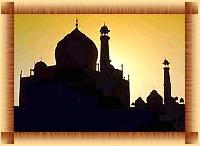
The Taj Mahal
We have a Special Tour Package for one of the seven wonders of the world.
...more
sikkim tour services
When I have visited Sikkim I was 11 year old & that time I was with my family. But at that time I was too young to understand the beauty of the Mother Nature. And I was so confused what I am doing here, No play grounds and no water parks. At that point of time I was not getting any hint that I will be coming back to the same place to explore what I have missed when I was a kid. After one year of visiting Sikkim I am sharing my unforgettable memories with you. It is the best destination I have ever seen in my whole life. Gangtok is the capital of Sikkim, occupies the west side of a long ridge flanking the Ranipool River. The scenery is spectacular & there are excellent views of entire. Kanchenjunga range from many points in the vicinity. Many people expect Sikkim to be a smaller part of Kathmandu overflowing with ancient temples, palaces, monasteries & narrow colorful bazaars. Its, not, but it is an interesting & pleasant place to stay the people here are exceptionally friendly. Its main attractions, other than trekking up to the Kanchenjunga (the second highest peak in the world). Tsuk-La-Khang : It is the place where I really find such inner peace which I never realized that one can get it in his her life. The whole surrounding looks like, that some one came over here & paused all nature beauty. The only sound which may reach to your ears is your own heart beat. The Royal Chapel is the Buddhists principal places of worship & the repository of a large collection of scriptures. It is a beautiful & impressive building, & its interior is covered with murals. Lavishly decorated altars hold images of the Buddha, bodhisattvas & Tantric deities & there are also a great many fine woodcarvings. A notice outside the entrance opposite the secretariat says, No sightseeing beyond this point. However, if you approach the army officer inside the compound & courteously ask for permission to visit, it will be equally courteously granted, but you must remember that photography is forbidden. Namgyal Institute of Tibetology: This traditional building was built in the year 1958, this unique institute promotes research on the language &traditions of Tibet, as well as on Mahayana Buddhism. It has one of the largest collection of books of world & rare manuscripts on the subject of Mahayana Buddhism. It also has a number of religious art & craft works, as well as books, for sale. Orchid Sanctuary : If you are echo friendly & really want to discover the true beauty which God had created in the form of species, this place which is definitely going to give you a lifetime memories. You can also realize that it is not an easy task that the officials in this sanctuary are playing to make all the arrangements. Surrounding the institute & itself enclosed by a peaceful forest is the Orchid Sanctuary, where you can see many of the 454 species of orchid found in Sikkim. Deer Park : This popular viewpoint is on the edge of the ridge next to the Secretariat building. In it, as you might expect, are deer & a replica of the Buddha image at Sarnath in Uttar Pradesh, as well as a caged bear, which anyone a vague sympathy for the Animal Liberation movement would want to see released. Lall Market : If you have been to markets in Kathmandu or Darjeeling, this one may come as a disappointment due to its limited range of craft shops, but the vegetable market is certainly colorful & there is plenty of activity. Khechepari Lake : Pronounced as catch a Perry, & sometimes spelt Khechepari, the standard hike from Palling is to walk to the lake in one day by taking one of the several downhill trails to the Rimbi River, crossing either a bamboo or steel bridge, & then going uphill either by a steep trail or via the winding motor road. Railways : The nearest railheads are at Siliguri New Jalpaiguri & Darjeeling have toy train between Siliguri & Darjeeling has been suspended for number of years. Roadways : There are plenty of domestic bus routes within Sikkim operated by SNT. It is one of the easiest way to get around, some of the private travel operators provide there services for intercity & interstate transportation. For the transportation you can also get a private taxi or the cabs. Climate : As Sikkim is situated in Himalayan range temperature always remain cool in summer & in winter it get decreased till 10C to -30C. Further Connections : Guwahati, Shilong and Kaziranga National Park.
...more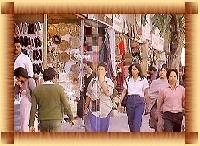
Shoppers Stop
Duration : 15 Nights 16 DaysDestinations : Delhi - Jaipur - Deogarh - Udaipur - Jodhpur - Samode - Ranthambhore - AgraDay 01 : New DelhiWelcome to India. You will be received by our representative at international airport and assisted to your hotel. Rest of the time free for leisure. In the evening move out for a walking tour of the old streets of the Delhi. Day 02 : New DelhiAfter a leisurely breakfast move out visit Mother Theresa’s Orphanage. Further move out for a sightseeing tour of the city that includes visiting to the Red Fort, Chandni Chowk & Jama Masjid along with other attractions. Evening free to move around the colourful markets for shopping.Day 03 : New DelhiIn the morning move out for an excursion to the birthplace of your daughter in Uttar Pradesh. Rest of the day completely on your discretion.Day 04 : JaipurIn the morning drive to the charming Pink City ‘Jaipur’ in your exclusive vehicle. On arrival check in to your hotel. Rest of the time free for leisure. In the evening you may walk in the old Bazaars of the Pink City.Day 05 : JaipurAfter a leisurely breakfast move out for a day long sightseeing tour of the Pink City that includes visiting to City Palace, Jantar Mantar, Hawa Mahal, and the Amber Fort. In Amber Fort you may also enjoy the Elephant ride. In the evening move out to realize the local Rajasthani Dinner at a farmhouse restaurant. Day 06 : DeogarhIn the morning drive to Deogarh in your exclusive vehicle. The whole day on your discretion. Suggested visit to Molela village (famous for terracotta crafts) or Kumbhalgarh fort. Option of taking a unique safari on horses to the villages in this region of rugged terrain. Day 07 : UdaipurDrive to Udaipur ‘the Lake City’ in your exclusive vehicle. Relax for a while. Take a boat trip over Lake Pichhola at sunset. Optional dinner at opulent Shiv Niwas Palace.Day 08 : UdaipurAfter having leisure breakfast Day sightseeing of City Palace, Saheliyon ki Bari, Eklingji and Nagda. Remaining day, as you prefer.Day 09 : JodhpurIn the morning drive to Jodhpur in your exclusive vehicle. On arrival check in at hotel and later visit the majestic Mehrangarh fort and the busy bazaars around Clock Tower in the old town.Day 09 : JodhpurExcursion to Osian temple town or half day jeep safari in Bishnoi villages. Back at Jodhpur rest of the time free to shop around the bazaars. Day 10 : SamodeDrive to Samode, a fairy tale like village with an equally charming palace as your place of stay. At Samode, you may have an enjoying camel ride over the sand dunes or explore the heritage character of the village. Evening at leisure watching cultural performances. Day 11 : RanthambhoreAfter having a leisurely breakfast drive to Ranthambhore. On arrival check in at your hotel. Relax for a while. Move out for an open jeep safari to watch the Royal Bengal Tigers in their natural habitat.Day 12 : Ranthambhore Morning we move out for jungle safari to see the rare Indian tigers in full glory at the Ranthambhore National Park. After lunch we try another chance in safari of National Park. Day 13 : RanthambhoreTake the open jeep safari to take the Royal Bengal Tiger one on one. Rest of the day free for leisure. In the evening visit to peaceful Ranthambhore Fort. Day 14 : AgraIn the morning move out for a Jungle safari for wild life viewing. Further drive to Agra by your exclusive vehicle. On the way visit to the Fatehpur Sikri. On arrival check in. Rest of the Day completely on leisure. Day 15 : New DelhiIn the morning visit the Agra Fort and incomparable Taj Mahal in a guided sightseeing tour. Later drive to New Delhi. Rest of the free for Leisure. Day 16 : DepartureAt appropriate time you will be transferred to the international airport to board the flight back to home the tour ends.
...more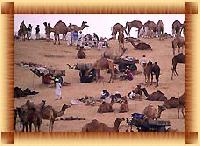
Pushkar Fair
Pushkar is a sacred town for the Hindus, situated 11 kms. to the north-west of Ajmer. About 400 temples and shrines are located at Pushkar around its holy lake, which finds a mention in the Padma Purana. Legend has it that Lord Brahma in search for a spot to hold his yagna (religious ritual), dropped the lotus from his hand, the three spots touched by this flower were turned into lakes. These are today known as the Jyeshtha Pushkar (main Pushkar), the Madhyam Pushkar (medium Pushkar) and the Kanishtha Pushkar (little Pushkar). A temple dedicated to Lord Brahma is located at Pushkar; the other important temples are those of Gayatri, Savitri, Shiv and Badri Narayan.THE HOLY DIPS (SNAN)People consider the water of the Pushkar Lake to be very sacred and the ritual of taking dips in the holy water is believed to bestow salvation. The holy dip is most auspicious on Kartik Poornima. Even before sunrise, people descend the ghats, aided by the pandas (Brahmin priests) to take the sacred bath. Offerings of coconut, flowers, and cash are made to the lake and the priests. Visiting the TempleAfter bathing at the lake, people proceed to pay homage to the creator of the Universe, Lord Brahma, at the Brahma Temple.PARIKRAMAMost pilgrims perform the oblations at the Jyeshtha Pushkar while some opt to visit all the three Pushkar and this is called the Panch-Kosi-Parikrama. Many pilgrims visit all the shrines at Pushkar in seven days and this is called the Chaubis-Kosi-Parikrama. FLOATING LAMPS (DEEP DAN)It is customary to float lighted earthen lamps after placing them on pattals (plates made of leaves) on the waters of the lake. This creates a spectacular view in the evening when the sacred lake takes on a mystical tint sprinkled with twinkling spots of light. Aarti is offered at the lake in the morning and evening.CATTLE FAIR (PUSHKAR CAMEL FAIR) In conjunction with the religious fair, a cattle fair is also organised in the month of Kartik at Pushkar Cattle-breeders bring a large number of cattle of various popular breeds such as Nagauri, Haryanvi, Mewati, Kankrej etc. to the fair to be sold to the rural folk who appreciate well-bred animals. The cattle are decorated by their owners during Pushkar fair and also participate in the races and are paraded on the sand dunes.PUSHKAR FAIRThe ancient town of Pushkar is transformed into a spectacular fair ground in the month of Kartik. The fair attracts a great number of tourists from far and wide. The fair-grounds reverberate with festivity, as rows of make shift stalls display a bewildering array of items that compete with each other for the visitors attention. But the highlight of Pushkar fair is the trading in camels. Camels are bought, sold, decked up and paraded on the sand dunes, presenting a picturesque sight. The camel, horse and donkey races are events that draw huge attendance. Body tattooing is yet Horse race. Pushkar another favorite activity that attracts a large number of enthusiasts. The Pushkar fair brings together a large number of villagers from different parts of the state. Some come here to sell. Some come here to buy. Some come here on a pilgrimage. Still others come here just to enjoy the festivities. The days are filled with fun and activity. The evenings are filled with music and dance. Come dusk, and the rich strains of haunting music are carried across the desert sands as the merrymaking continues deep into the night. The profusion of colours that run riot in the desert sands, the glee and the contagious enthusiasm of the village folk are a unique experience for every visitor. On this special occasion, the Rajasthan Tourism Development Corporation (RTDC) puts up a tourist village. The tourist village is self-sufficient and specially designed to complement the natural beauty of the site. It has a Coffee Shop and Dining Hall, which can cater to 1500 guests at a time. The village is arranged in blocks of tents, each with its own identity, named after the famous dances of Rajasthan. The village also has huts with attached western style toilets and running water. One can also stay at Sarovar Hotel, Pushkar or in Ajmer at the RTDC Tourist Bungalow-Khadim. ReligiousThe Pushkar Lake is surrounded by 52 flights of steps, called ghats, many having special legendary importance. Lord Vishnu is said to have appeared at the Varah Ghat in the form of a boar. Brahma took a bath here and performed Yajna at the Brahma Ghat, accompanied by Vishnu and Mahadev. Guru Govind Singh chose this site for reciting the sacred Guru Granth Sahib. The ashes of Mahatma Gandhi were immersed at the Gandhi Ghat, which was previously called Gau Ghat. How to get thereBy AirJaipur at 146-km is the nearest airport. By RailAjmer at 11-km is the nearest railhead from Pushkar. By RoadPushkar is well connected by road and is 11-km from Ajmer. TimingsThere is a steady flow of pilgrims throughout the year to Pushkar, which is among the five principal places of Hindu pilgrimage. It is, however transformed into a bustling fair-ground in the month of Kartik (October-November) when the annual Pushkar Fair and a cattle fair are held simultaneously. The fair starts from Kartik Shukla Ekadashi and goes on for 12 days, till Kartik Purnima. Both the religious fair and the cattle fair are now internationally renowned tourist attractions. A small fair is held in the month of Baisakh, which is primarily a local event. Location11km North-West of Ajmer, Rajasthan.Unique FeaturesHindu Pilgrimage.Main AttractionPushkar Lake, Brahma Temple, Cattle Fair. Recreation CentersA large number of traders gather at the Pushkar Fair and set up shops. They sell a host of products like bead necklaces of Nagaur, woollen blankets of Merta, textiles printed in Ajmer and Jodhpur, brassware of Jodhpur and Jaipur etc. Also on sale are saddles, ropes, and assorted household items. During the fair, cultural shows and exhibitions are organised to enliven the event. Movies are shown and competitions are arranged. Bards and poets recite and sing tales of valour and heroism of bygone days. Animal races and other competitions add to the attraction.
...more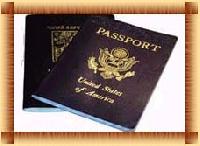
Passport and Visas
Passport : All travelers to India except nationals of Nepal & Bhutan must possess a valid passport. It is advisable to carry your passport with you while you are in India for possible identification requirements. Always place a photocopy of your passport in each and every checked-in baggage that you give at the airport. This helps in case you lose your luggage.Visa: All foreign tourists to India except nationals of Nepal, Bhutan & Bangladesh, must possess a valid visa. You are not issued a visa on your arrival in India. The cost of a visa is US$ 30 for up to six months, US $ 50 for up to one year and US $ 100 for more than one year and up to five years. Contact the Indian embassy or Indian consulate in your country for issuing of Visas. A tourist visa is valid for three to six months. Tourists visas allow multiple entry to simplify visits to neighboring countries. You will be required to fill in a disembarkation card on your arrival in India which will have to be submitted at the Immigration counters at the airport.Transit Visas: Transit visas are granted by Indian Missions abroad for a maximum period of 15 days.Exemption from Registration: Foreigners coming to India on tourist visa for 180 days or a shorter period are not required to register themselves with any authority. They can move about freely in the country, except to restricted protected areas and prohibited places. Nationals of Bangladesh are exempt from registration for up to six months. If their stay exceeds six months, they have to register themselves. Family passports issued by other governments are recognized with discrimination.Extension of Visa: As a rule, no extension of stay is granted on a tourist visa. Tourist visa are available for a maximum period of 180 days. No charges are levied for visa extension within the maximum period of 180 days. Identical passport photographs are required. However in case of an extension beyond 180 days, which is allowed only in exceptional cases, an extension fee which varies from country to country is charged. In case a foreign tourist has obtained extension beyond three months of stay in India, he will have to surrender his certificate of Registration and Residential Permit before leaving India.
...more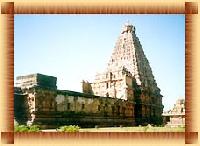
Now See South India
Duration:20 Nights 21 DaysDestinations: Mahabalipuram- Pondicherry - Tanjore - Mudurai -Kumarakom - Kettovlam - Kochi - Bangalore - Chikmagalur - Hampi - Badami - Goa - MumbaiDay 01 : Chennai - MahabalipuramWelcome to India, You will be received at the international airport of Chennai and will be further transferred by car to Mamallapuram. Day free to relax in your beach side resort.Day 02 : MahabalipuramMahabalipuram(Mamallapuram) is famous for it’s shore temples and other monuments which are in a form of epic recreated on stone. Morning walk over the seashore and explore the temples on own. To add some more colors in your evening visit to the Dance Festival.Day 03 : PondicherryIn the morning drive to Pondicherry in your exclusive vehicle, the erstwhile French colony Pondicherry of beautiful boulevards, gothic structures and quiet beaches. Day at your discretion.Day 04 : TanjoreDriving down to fertile rice growing plains of Cauvery reach Tiruchirapally. Nearby visit the enormous Srirangam temple and then continue to the Chola citadel of Tanjore. Visit the World heritage Brihadishvara temple- simply unparalleled!Day 05 : MaduraiIn the morning drive to Madurai in your exclusive vehicle. Day to be spent completely at leisure or to soak in the unique Dravidian cultural atmosphere of this ancient temple city. Day 06 : KumarakomReach Kumarakom in a beautiful hill drive through spice plantations- Kumarakom is an island with a beautiful bird-sanctuary and extremely serene atmosphere. Stay at Coconut Lagoons- a wonderful resort providing restored tharawads as idyllic rooms.Day 07 : Kumarakom Day free to relax and explore around. Enjoy highly benefitial rejuvenating Ayurvedic massages, try great coastal food and watch spectacular Kathakali dance performances.Day 08 : Kettovlam HouseboatsDay till noon free to relax in the resort with traditional Ayurvedic therapies as the most suggested facility for rejuvenation. After lunch board your exclusive kettuvalom to sail through Kerala’s most enchanting backwater scenery. Kettuvalom is a traditional rice barge converted into a houseboat having all boarding and lodging facilities. Overnight on board.Day 09 : KochiAfter a short drive reach Kochi - the cultural and commercial hub of Kerala. Day sightseeing at Fort Kochi. Visit the Mattancherry palace, Jewish synagogue, Jew town, old spice markets, St. Francis church, Santa Cruz Basilica and Chinese fishing nets. Evening free to explore the vibrant markets.Day 10 : BangaloreAfter a leisurely breakfast we board a flight to Bangalore. On arrival you will be received and assisted to your hotel and check in. At Bangalore visit Cubbon Park, Lal Baug and intersting public buildings within Cubbon Park.Day11 : BangaloreExcursion to Nrityagram- a center for learning of Indian classical dances set up by noted Odissi dancer Protima Bedi. Rest of day left free to move around at M.G.Road area.Day 12 : Bangalore Day free to relax and explore around.Day 13 : ChikmagalurDrive to Chikmagalur (which means Younger daughter’s village) in your exclusive vehicle, a peaceful hilly area. Visit Halebid temple, one of the best example of Hoysala Hindu architecture in India.Day 14 : HampiDrive to Hampi in your exclusive vehicle. Day free for leisure.Day 15 : HampiVisit Hampi that has extraordinary remnants of once great city Vijayanagara. The sheer size and majestic appearance of this historical site is amazing! Day free to explore around the great monuments that dot the whole area. Take a walking tour of the Hampi bazaar and temples. Cross the picturesque Tungabhadra River on a primitively designed corracle- a very different experience! Day 16 : BadamiDrive to Badami in your exclusive vehicle. Badami was once the capital of Chalukyan empire and today it boasts some of the most beautiful rock cut temples of that period. Visit the grand Virupaksha temple of Pattadakal and cave temples of Aihole.Day 17 : GoaDrive to India’s beautiful western coastline and reach Goa- the exotic tropical beach destination. Day free to walk around the beaches.Day 18 : GoaSightseeing tour of Old Goa and Panjim for beautiful churches and cathedrals. Mandovi River cruise. Day 19 : GoaDay at discretion in the tropical paradise known as Goa. Day 20 : MumbaiIn the morning we board a flight to Mumbai. On arrival you will be received and assisted to your hotel. Later day trip to Elephanta cave island for astonishing ancient sculptures. Later during the day visit notable attractions of the city which includes Dhobi Ghat, Crawford market, Marine drive and old mansions of Colaba area.Day 21 : DepartureAt appropriate time, transfer to international airport to board your flight back home. The tour ends.
...more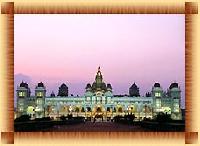
Mysore tour services
Sandalwood City! Everywhere you go in this beautiful city you will find yourself surrounded by the lingering aromas of sandalwood, jasmine, rose, musk, frangipani & many others. Whenever you smell them again, you will be reminded of this place. It is one of the major centers of incense manufacture in India, & scores of small, family- owned agarbati (incense) factories are scattered all over the world. Until Independence the city was the seat of the Maharajas of Mysore, a princely state covering about a third of present- day Karnataka, centre of the city is a major attraction drawing the visitor from all over the world. Just south of the city is Chamundi Hill, which is topped by an important Siva Temple. Maharaja Palace : The beautiful profile of this walled Indo- Saracenic palace, the seat of the maharajas of Maharajas, graces the skyline of city. It was built in 1907 at the cost of 4.2 million to replace the former palace which burned down. Inside it is a kaleidoscope of stained glass, mirrors, gilt & gaudy colors. Some of it is undoubtedly over the top but there are also beautiful carved wooden doors & mosaic floors, as well as a whole series of mediocre, though historically interesting, paintings depicting life in Mysore during the British rule. Note the beautifully carved mahogany ceiling, solid silver doors, white marble floors &superb columned Durbar hall. The palace even has its own Hindu temple inside the walls, complete with gopuram (gateway tower). There is a good museum adjacent to it. Chamundi Hill : You can spend a very pleasant half- day walking up (or, more sensibly, down) the 1000- odd steps to the top of the hill, where the temple to Sri Chamundeswari, stand 1062 meters above the sea level. There is some shade on the way & the views over the city & surrounding countryside are superb. Three- quarters of the way up the hill you will come across the famous Nandi (bull of Siva) carved out of solid rock which, at five meters high, is one of the largest in India. It is always garlanded in flowers & constantly visited by bevies of pilgrims offering parsad (a sweet dish offered after the pray) to the priest in attendance there. Jaganmohan Palace : Another place to worth a visit is the Jayachamarajendendra art gallery in Jaganmohan Palace. Not only dose it display paintings, particularly by Ravi Verma, but it is handicrafts, historical objects, of interest & rare musical instruments. The palace itself was built in 1861 & served as a royal auditorium. Helping Facts Airways : Mysore has its own domestic airport. And one can find the flights to all over the country from here. Railways : Since Mysore is on the meter- gauge system & not on any of the major trunk routes, getting to any of other major cities of India, except Bangalore, involves the change of trains at some point. Roadways : The central bus station is not far from the centre of Mysore. There is the time table available in English & you can make your reservations three days in advance. From the central bus stand you can get the non-stop buses to Banglore every 15 minutes from 5.45am to 9.30pm as well as super deluxe buses every hour from 6.30am to 7pm. Climate : Climate over here in the summer season is much hot the temperature her in Mysore in the summer season remains around 340C- 370C. The temperature in the winter season it gets reduced & decreases up to 120C- 140C. Further Connections : Bangalore, Mangalore, Hampi and Cochin.
...more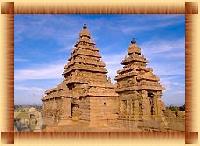
Mahabalipuram tour services
Mahabalipuram with its picturesque location on a rocky outcrop between the beach and a lagoon is a happy combination of history, good beaches, hassle-free tourism and fabulous fish and lobster! Despite the many visitors, drawn by the former Pallava dynasty town, the place is friendly, relaxed, and the villagers are remarkably unperturbed by their crowds of visitors. Mahabalipuram is renowned for its series of charming rathas and the spectacular carved relief depicting Penance of Arjuna. The magnificent Shore Temple, built by king Rajasimha in the seventh century, is a unique temple that houses the shrines of both Shiva and Vishnu while the Varaha Cave is one of the many rock-cut caves in Mahabalipuram. The Krishna Mandapam has a bas-relief of Lord Krishna lifting the Govardhan hill in his fingertips. Mahabalipuram also close to Chennai (Madras) is on the shores of the Bay of Bengal, along the eastern coast. Mahabalipuram known for its rocks carvings and monolithic sculptures has the famous shore temple, the only one to have survived the ravages of nature. Also known as the Seven Pagodas (temples), six now lie submerged in the sea. Mahabalipuram art can be divided into four categories: open air bas - relief, structured temples, man-made caves and rathas (chariots carved from single boulders, to resemble temples or chariots used in temple processions). The famous Penance of Arjuna and the Krishna Mandapa, adorn massive rocks near the centre of the village. The beautiful Shore Temple towers over the waves, behind a protective breakwater. Sixteen man-made caves in different stages of completion are also seen, scattered through the area. CavesThe Varaha Cave, a small rock-cut mandapam (hall), is a faceted and finished gem with two incarnations of Vishnu-Varaha (boar) and Vamana (dwarf). Particularly noteworthy here are four panels of the famous Pallava doorkeepers. There is about them a mood of contemplative reverie, a lyrical softness and subtle grace totally at variance with the primordial machismo their role as guards of the gods imposes on them. The Dharmaraja Cave, built in the early seventh century, contains three empty shrines. The Mahisasurmardini Cave (mid-seventh century) has fine bas-reliefs on its panels of enduring beauty. The Somaskanda sculpture radiates peace, power, and wisdom while Lord Vishnu is shown in omniscient repose in a masterpiece of dhwani (the art of suggestion). On the opposite side is a huge theatrical panel showing, Goddess fight of Durga with the demon Mahishasura, an episode culled from the celebrated Sanskrit poem Devi Mahatmya. About 5 km north of Mahabalipuram is another cave called Tiger Cave, a rock-cut shrine possibly dating back to 7th century. RathasA group of structures lying at the southern extreme of Mahabalipuram, amidst casuarina trees, are the famous Rathas (chariots). The Pancha Pandava Rathas, as they are called, are five in number. Out of these, four are carved out of a single rock, while the fifth on the west is scooped out from a small rock. The square Draupadi and Arjuna Rathas, the linear Bhima Ratha, the taller Dharamraja Ratha and the apsidal Nakula-Sahadeva Ratha, constitute the complex. Krishna MandapamThe Krishna Temple is one of the earliest rock-cut temples of Mahabalipuram. The walls of the temples depict scenes of pastoral life, one with the image of Krishna lifting the Govardhan Hill in his fingertips to protect his people from Indra. Events and FestivalsPongal, the most important festival of the Tamils is celebrated in mid-January every year. The festival is celebrated amidst gaiety and joy not only in Tamil Nadu but also in most parts of South India. Mahabalipuram Dance Festival is an occasion for the dance lovers to enjoy the performances of the artists from all parts of the country. The festival is celebrated in the month of JanuaryFebruary every year. The Shore Temple forms the backdrop of this festival and the music from the musical instruments mixes with the natural music of wind and the sea. The Mahabalipuram Dance festival is an occasion when artists from all over the country come together to perform. The Sthalasayana Perumal temple festivals, Masimagam and Brahmothsavam, are held in the month of March. How to get there Air : Chennai (58-km) is the nearest airport with both domestic and international terminus. Chennai is connected with all the major places in India through the numerous domestic flights. International flights operate from various parts of the world to Chennai. Rail : The nearest railway stations are Chengalpattu (29-km) and Chennai (58-km). From these stations one has to take road to reach the Mahabalipuram. Road : Buses are available from Pondicherry, Kanchipuram, Chengalpattu and Chennai to Mahabalipuram daily. The road to Mahabalipuram is good. Tourists can also hire a taxi from Chennai. Climate: Mahabalipuram is located on the south-east cost of India, The weather is very humid. Average rainfall is 1050 mm per year. The peak tourist season is from October to March.Further Connections : Chennai, Cochin, Madurai and Pondicherry Tour to MahabalipuramNow See South IndiaDuration : 20 Nights 21DaysDestinations : Mahabalipuram - Pondicherry - Tanjore - Mudurai - Kumarakom - Kettovlam - Kochi - Bangalore - Chikmagalur - Hampi - Badami - Goa - Mumbai
...more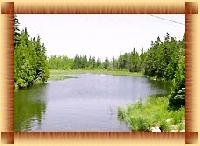
Kumarakom tour services
When nature is all you need to recuperate, Kumarakom is undoubtedly the most invigorating, fascinating paradise in Kerala, Gods own country. The slender coconut palms standing here, there and everywhere, its never ending paddy fields, meandering lagoons and backwaters, mangroves nesting birds of a hundred varieties can peacefully calm and invigorate your mind with renewed inspiration for your vocation and life. That is the pristine beauty of Kumarakom. Kumarakom the charming emerald peninsula jutting into the ever-effervescent Vembanad Lake takes you into the heart of the scenic lake where you will come across plenty of traditional country crafts, boats and canoes. The fresh water of the lake runs into the mainland making a labyrinth of lagoons, brooks, canals and waterways. The backwater houses a variety of species of both fauna and flora. They are rich with marine life namely the exclusive Kumarakom Karimeen (pearl spotted fish), Konju (tiger prawns), Njandu (crabs), Chemeen (prawns) and many more.As the monsoon winds bring rain to the shores of Vembanad Lake, the Kumarakom is transformed into a rich fertile land. The streams, lagoons, brooks break their banks and provide nourishment to springs and shrubs that sprout from every available space. Water birds, migratory birds, mangrove shores and the renowned bird sanctuary form their niche. The resorts nearby offer comfortable accommodation and exclusive leisure options like an Ayurvedic massage, yoga, meditation, boating, fishing and swimming. The adventurous could indulge in water sports such as windsailing and waterskiing. You could even take a canoe out into the quite lakes and armed with a fishing rod, catch your own supper. Make sure you do not miss out on Karimeen and fresh toddy, the favorite fresh water food and the local wine. BackwaterKerala is known for its panoramic backwater stretches, lush green paddy fields, highlands and beaches. The major backwater stretch is in Kottayam district, where a network of rivers and canals empty into the great expanse of water called the Vembanad Lake. Located at Kumarakom 16 km from Kottayam town, the Vembanad Lake, an enchanting picnic spot and a fast developing backwater tourism destination, provides boating, fishing and sight seeing experiences that are truly exhilarating. Kumarakom slumbers on the banks of the famous Vembanad Lake. The Vembanad Lake with its majestic canals, streams and distributaries along its banks weave an intricate and enchantingly beautiful web. The gorgeous green of the fringed palms ripple in the blue waters and blend into wavelets. The entire state of Kerala is blessed with plenty of rivers and the resources of many are still untapped. The waterways of Kerala play a main role in the economy of the state, links remote villages and islands with the main land. The water ways provide a cheap and economical mode of transport. It is incredibly different experience to cruise in the backwaters in country boats, absorbing the beauty of Kerala villages. The scenery flashes up vivid contrasts of breath-taking greens and deep blues. Boat rides, houseboat cruises and holiday packages are available for tourist and others at nominal rates.The serene lake comes alive during Onam with a spectacular water regatta-the snake boat races. It is indeed amazing to watch oarsmen, at least a hundred in one boat, slice their way through the waters to the rhythm of their own full throated singing.Helping FactsBy Air : From the Trivandrum International Airport it is a 171 Km (approximately 3 hours ride by road) to the Muhamma boat jetty. If you have arrived at Cochin International Airport, perhaps you might prefer a ride through the backwaters to Alleppey. There are many boats services offered at CochinBy Road : From the Cochin International Airport it is an 85 Km delightful ride by road to the Muhamma boat Jetty. From the Trivandrum International Airport it is a 175 Km (approximately 3.30 hours ride by road) to the Muhamma boat jetty. From the Calicut International Airport it is 180 Km ride to Muhamma. By Rail:From Bombay, Madras or Bangalore, you can take a train to Kerala. The best place to alight is either Cochin or Kottayam (the nearest railhead, just 16 Km away by road). Kottayam links you to all major cities in Kerala and India with numerous trains plying this route daily. From Cochin, you could also take a south bound train via the Alleppey route (enjoy picturesque scenery as the route flanks the backwaters and the sea on its way). Alight at Chertala for a short 14 Km ride to Kumarakom.By Water : If you have arrived at Trivandrum International Airport, come to Quilon by road or rail (takes just about one hour). From there, you can take the regular ferry service to Alleppey - a long and delightful ride on backwaters of Kerala. From Alleppey, it is just a short ride to Kumarakom. If you have arrived at Cochin International Airport, perhaps you might prefer a ride through the backwaters to Alleppey. There are many boat services offered at Kochi.Climate : Kumarakom enjoys a well-balanced tropical climate. The lowest and highest temperatures recorded are 16.10 C and 37.80 C. There is always a cool, fresh breeze, which makes even the warmest weather readily agreeable. The South West monsoon is from early June to early August. However, slight drizzles persist till early November. Average rainfall is 1100 mm per year. The peak tourist season is from November to March.Further Connections : Cochin, Trivandrum, Periyar National Park and Chennai. Tours to Kumarakom Land of Back WaterDuration : 18 Nights 19 DaysDestinations : Kochi - Munnar - Madurai - Periyar - Kumarakom - Houseboat - MarariNow See South IndiaDuration : 20 Nights 21DaysDestinations : Mahabalipuram - Pondicherry - Tanjore - Mudurai - Kumarakom - Kettovlam - Kochi - Bangalore - Chikmagalur - Hampi - Badami - Goa - Mumbai
...more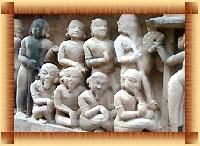
Khajuraho
Of the love of man and woman, these are few representations anywhere, so tender and full of charm as those on the temple of Khajuraho. In the maze of each wall, one can search for immortally in certain images, which are as though breathing, according to the highest ideals of imaginative skill of Indian ancient craftsmen. It is very difficult to create these types of masterpieces and the best part is that not a single statue is look alike to other statue. I have described few of the best imagination of the people who build these immortal temples. "Mohini (a young girl) looks into the mirror with her head inclined in the narcissus mood of a young girl awaking her own beauty" "A hero, with the lion shoulders and the profiles of a got, is bending his head graciously over the beloved, who looks up to the lover, until their four eyes meet" "The body of another lover is fused in coition with that of the , in the most sensitive adoration, where each is both" "Still another male is protecting his frightened female companion against a monkey" "A dancer with a cylindrical body is tying the bells on her feet, to get ready for the sway of her limbs in dance" "The musician plays on the flute, the drams and cymbals" There are orgies of love-making in palaces of kings, with the shy maids-in-waiting, standing or helping, with faces slightly averted from the privacy of the union. The play-function of sex, which Vatsayayana (who wrote the Kamasutra) had insisted upon, apart from sex for the procreation of new life, is shown with an abandon of ecstasy everywhere. But if people bring to Khajuraho, the cold stare of erotic curiosity from a prurient curiosity, without any heart, then the whole panorama on the walls, congested with the lush imagery of love-play will fall flat on their empirical egos. Ostensibly, the intention of the builder was not to afford to the vulgar, compensatory pleasure, such as they have never enjoyed in life, but to celebrate the happiness of loving. There are certainly a number of postures, which looks odd to those who have never been possessed by passion. There are some conjugation which only adepts, with full control on their minds and bodies and hearts could perform. And there are a number of jokes, such as the inferior craftsman in all the temple and cathedrals of the world perpetuated from their lowest consciousness.
...more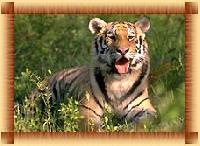
Indian Wildlife tour services
Duration : 09 Nights 10 DaysDestinations : New Delhi - Bandhavgarh -KanhaDay 01 : New Delhi - Over Night In the TrainAt appropriate time you will be picked from the desired location and transferred to the train station to board the train for Umaria (Bandhavgarh). Over night in the train. Day 02 : BandhavgarhOn arrival you will be received and transferred to the Bandhavgarh National in your exclusive vehicle. On arrival check in to your jungle resort. Relax for a while further move out for a jungle safari for wild life viewing. Rest of the day completely on your discretion. Day 03 : BandhavgarhIn the morning move out for a jungle safari on the back of an elephant to shoot the Royal Bengal tigers by you Camera. After lunch move out for a jungle safari for wild life viewing. Rest of the day free for leisure. Day 04 : BandhavgarhIn the morning move out for a jungle safari in to watch the Royal Bengal Tiger in its natural habitat. After lunch we again take the elephant safari to explore what you missed in the previous safaris. Day 05 : KanhaIn the morning drive to Kanha National Park in your exclusive vehicle. On arrival check in to your jungle resort. Further move out for a safari in side the national park. Day 06 : KanhaMove out for Wild Life Safari to watch the Royal Bengal Tigers. After your lunch again go to find one of the wildest animal of the earth. Sharing your experience of the adventures day on the dinner table. Day 07 : KanhaIn the morning take a safari inside the Kanha National park. After lunch again take the jungle safari to explore what you missed in the previous safaris. Day 08 : KanhaIn the morning move out for a jungle safari on the back of a jungle safari to shoot the Royal Bengal tigers by you Camera. After lunch move out for a jungle safari for wild life viewing. Rest of the day free for leisure. Day 09 : Over night in the TrainIn the morning move out for a jungle safari to watch the royal Bengal tiger one on one. Further drive to Jabalpur in your exclusive vehicle to board the flight for New Delhi. Over night in the train. Day 10 : DepartureOn arrival you will be received at the train station and transferred to the international airport to board the flight back to home the tour ends.
...more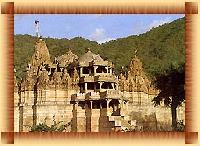
Indian Temples
Duration : 10 Nights 11 DaysDestinations : Udaipur - Ranakpur - Jodhpur - Jaipur - Agra - Khajuraho - Varanasi - Delhi - RishikeshDay 01 : UdaipurWelcome to India. You will be received at the international airport and transferred straight to the domestic airport to board the flight for Udaipur. On arrival you will be received and assisted to your hotel. Rest of day completely on your discretion. Day 02 : RanakpurIn the morning move out for a half day sightseeing tour of the city that includes City Palace, and Saheliyon ki Bari. Further drive to Ranakpur in your exclusive vehicle. On arrival check in at your hotel. Day 03 : JodhpurAfter a leisurely breakfast move out to visit the beautiful Jain Temple. Further drive to Jodhpur in your exclusive vehicle. On arrival check in at your hotel. Rest of the time at leisure. Day 04 : JodhpurIn the morning visit the majestic Mehrangarh fort and the busy bazaars around Clock Tower in the old town. Further drive to Jaipur in your exclusive vehicle. On arrival check in. Rest of the time at leisure.Day 05 : JaipurDay sightseeing of the City Palace Complex and Amber Fort. Here at Amber fort you may also enjoy the elephant ride. In the evening visit to a farmhouse for local Rajasthani dinner. Day 06 : AgraDrive through abandoned citadel of Mughal emperor Akbar known as Fatehpur Sikri. Transfer to Agra and later visit the most beautiful monument of love- The Taj. Also see Agra Fort during the day. Evening free on own.Day 06 : KhajurahoIn the morning you will be transferred to the domestic airport of Agra to board flight for Khajuraho. On arrival you will be received and transferred straight to your hotel. Further move out for the sightseeing tour of eastern group of Temples. Day 07 : VaranasiIn the morning you will be transferred to the domestic airport of New Delhi to board flight for Varanasi. On arrival you will be received and transferred straight to your hotel. Walking tour of a few Ghats and narrow backlanes to feel the pulse of this most sacred city of India. Day 08 : New DelhiIn the morning you will be transferred to the domestic airport of Varanasi to board flight for New Delhi. On arrival you will be received and transferred straight to your hotel. Rest of the day Completely on your discretion. Day 09 : RishikeshIn the morning you will be transferred to the train station to board the train for Haridwar. On arrival you will be received at the train station and assisted to your hotel at Rishikesh. Rest of the time completely on your discretion. Day 10 : New DelhiIn the morning you will be transferred to the train station of Haridwar to board the train for New Delhi. On arrival you will be received and transferred to the your hotel rest of the time at leisure. Day 11 : New DelhiAt appropriate time you will be transferred to the International airport to board the flight back to home the tour ends.
...more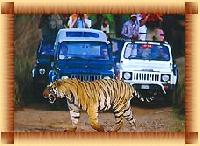
Indian Jungle
Duration : 09 Nights 10 DaysDestinations : Bharatpur - Ranthambhore - CorbettDay 01 : BharatpurWelcome to India. On your arrival you will be received at the international airport and will be assisted to your exclusive vehicle. Further drive to Ghana National Park in your exclusive vehicle. On arrival check in to your hotel. Rest of the time completely on your discretion. Day 02 : BharatpurEarly morning, have a completely rewarding experience of seeing an overwhelming range of birds during therickshaw trip into the Keoladeo Ghana National Park. In the evening again move out for boat ride for wildlife viewing inside the national park. Rest of the time free for leisure. Day 03 : RanthambhoreIn the morning drive to the Ranthambhore National Park in your exclusive vehicle. On arrival check in at your hotel. After lunch we move out for jungle safari to see the rare Indian tigers in full glory at the Ranthambhore National Park. Day 04 : RanthambhoreMorning we try another chance in safari of National Park. After lunch again take jungle safari to explore what you missed in first two. Rest of the day completely on your discretion. Day 05 : RanthambhoreIn the morning move out for Jungle safari to watch the Royal Bengal tiger one on one. In the evening move out inside the national park for wild life viewing. Rest of the day at leisure. Day 06 : Over night in the TrainMorning free for leisure. At appropriate time drive to the New Delhi to board the train for Ramnagar. Over night in train. Day 07 : CorbettOn arrival you will be transferred straight to your hotel. Relax for a while. Move out for an elephant safari for wild life viewing. Overnight at your jungle resort. Day 08 : CorbettIn the morning move out for an open jeep safari to take the Royal Bengal Tigers one on one. After lunch again take an elephant safari to explore what you missed in first two. Day 09 : Over night in the TrainIn the morning drive to Kaladungi (a beautiful place for bird watching). Rest of the time free for leisure. At appropriate time you will be transferred to the train station to board the for New Delhi. Over night in the air-conditioned saloon. Day 10 : DepartureOn arrival you will be received and will be transferred straight to the international airport to board the flight back to home. The tour ends.
...more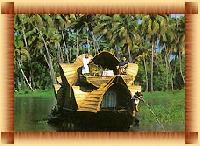
Houseboats
Houseboats of Kerala are a unique way to experience the beauty of kaleidoscopic Kerala. Transportation of men and material using houseboats of Kerala is nothing new. Though, the concept of staying in houseboats of Kerala is gaining popularity now. Houseboats on backwaters of Kerala are a major tourist attraction. The houseboats glide on the backwaters of Kerala, with panoramic view passing by. You may take your pick from the luxury houseboats of Kerala, budget houseboats of Kerala, economy houseboats of Kerala, exotic houseboats of Kerala, romantic houseboats of Kerala, wooden houseboats of Kerala, Eco-friendly houseboats of Kerala, country houseboats of Kerala, single apartment houseboats of Kerala, standard houseboats of Kerala, superior houseboats of Kerala, traditional houseboats of Kerala, twin/double houseboats of Kerala, and static houseboats of Kerala.Catering to the needs of the tourists, nature tour on houseboats of Kerala, photography tours on houseboats of Kerala, Coir making tour on houseboats of Kerala, culinary tour on houseboats of Kerala, culture tour on houseboats of Kerala, honeymoon on houseboats of Kerala and heritage tour on houseboats of Kerala, to choose from. The country houseboat in Kerala is referred to as Kettuvallam. These eco-friendly houseboats are made from local materials like bamboo poles, coconut fiber, ropes, bamboo mats, carpets etc. Usually houseboats are the giant country crafts that are as long as 60 to 70 feet. The houseboats floating in the backwaters of Kerala make the most mesmerizing manner to exploring the kaleidoscopic Kerala. Through the palm-fringed lakes and the narrow canals the houseboats offer the tourists to Kerala an experience of a lifetime. Since times immemorial Kerala has used its lake and canals as a water network for transportation of men and material. Being aboard a houseboat is a tranquil, stress free adventure where you see the beautiful Kerala keep passing by. The cruise down the magical and mystical backwaters of Kerala is indeed a captivating experience. Besides gliding in the houseboats you may try exploring, swimming, dining, fishing, bird watching or just lazing in the sun. The houseboat holiday in Kerala promises to be a great escape. Cruising aboard the houseboats tourists are left spellbound by the beauty of the Kerala. The private houseboat trip indeed makes the trip to Kerala complete. For the budget tourists seeking to enjoy Kerala there are dormitories. The entire enchanting experience of the houseboats in Kerala ranges in duration and tariff. The houseboats of Kerala offer an innovative holiday idea besides being of a unique cultural heritage. Promoting the theme of holidaying aboard the houseboats in Kerala facilities have been added to the traditional kettuvallam. While aboard the houseboat in Kerala you may enjoy the facilities of a star categorized hotel. Usually the houseboats are well appointed with an open lounge, one or more bath attached bedrooms and a kitchenette. A houseboat in Kerala is usually, manned by a crew, comprising of a cook, guide and oarsman. Lazing and relaxing on the sun decks is one of the most popular activities on the houseboats in Kerala. Traditional lanterns take up the place of electricity on the houseboats in Kerala. On the houseboats you may enjoy the serene surroundings along with savoring the traditional specialties of Kerala. Fresh seafood adds to the sumptuous meals available on the houseboats.There are motorboats are available for hire to travel through the backwaters. The major places for backwater activities are Kollam, Cochin, Alappuzha, Vaikom and Kumarakom. Snake boat races through backwaters are a major tourist attraction. Land of Back WaterDuration : 18 Nights / 19 DaysDestinations : Kochi - Munnar - Madurai - Periyar - Kumarakom - Houseboat - MarariNow See South IndiaDuration : 20 Nights / 21 DaysDestinations : Mahabalipuram - Pondicherry - Tanjore - Mudurai - Kumarakom - Kettovlam - Kochi - Bangalore - Chikmagalur - Hampi - Badami - Goa - Mumbai
...more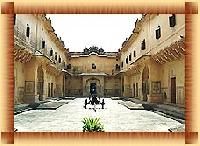
Heritage India
Duration : 09 Nights 10 DaysDestinations : Mandawa - Bikaner - Jaisalmer - Jodhpur - JaipurDay 01 : MandawaYou are picked up from Delhi, transferred to Mandawa & checked in hotel. We visit a few outstandingly frescoed Havelies in the town and watch the local dancesin the evening.Day 02 : MandawaRight from the morning we set out in the Shekhawati region to see a number of remarkable frescoes over the Havelies & Castles in the nearby towns of Dundlod, Nawalgarh and Laxmangarh.Day 03 : BikanerBefore reaching Bikaner we visit the Tal Chhaper Sanctuary made popular by its overwhelming number of black bucks. At Bikaner we visit the impressive Junagarh Fort & the Bhandasar Jain temples. We mark the evening to witness the timeless spectacle of the desert with camels and sunset at the National Camel Breeding Farm.Day 04 : JaisalmerIn the morning we drive to Jaisalmer on arrival check in. The only activity for the day with us would be the romantic experience of camel ride on the sand dunes at samm with Sunset, Music, Ballads & Dances. Day 05 : JaisalmerWe start out leisurely to see the various attractions in the town such as the incomparable & still inhabited fort, the temples, Havelis , palaces, Gadsisar tank and the maze of lanes and by-lanes. Evening free at leisure.Day 06 : JodhpurWe travel through the village of Kheechan and further through the ancient town Osiyan finally reaching the Suncity Jodhpur. We keep the whole day free for the activity of your choice and optional dinner at Umaid Bhawan Palace. Day 07 : JodhpurWe reach by jodhpur by noon. After some leisure we visit the majestic Maharangarh Fort, Umaid Bhawan Palace, Jaswant Thada and the Clock Tower. We take an optional dinner at Umaid Bhawan Palace.Day 08 : JaipurVery early morning we visit the one and only Brahma Temple. After breakfast we proceed for the final destination of our tour which is the city of many faces & ages as Pink City - Jaipur. We visit the Birla temple, the high posted Jaigarh Fort and the charming Nahargarh Fort from where the view of sprawling Jaipur city in the evening is unforgettable.Day 09 : JaipurWhole day we visit the various interesting parts of the city and the Amber Fort (Elephant ride).For the evening we wander through the unending bazaars of the Pink city. For the dinner we try out some Rajasthani delicacies at the ethnic village in the typical rural atmosphere.Day 10 : JaipurVery early morning we can try out the option of taking the spiritual tour of the old city & temples. Rest of the day free till departure for the onward journey. (The Tour Ends)
...more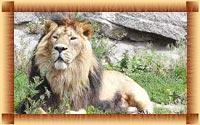
Gir National Park
Gir National Park The last home of the Asiatic Loin; a terrain composed of steep rocky hills, deep ravines and occasional stretches of grassland irrigated by many rivers. The park supports a mixed semi-arid deciduous forest. The Gir National Park is located among the low, undulating and excellently irrigated hills in the Junagadh district of Gujarat. It is famous for being the last existing natural home of the Asiatic lion, although it has a healthy population of other animal species too. The Gir forest covers an area of 1150 square kilometers with 300 square kilometers forming the core area of the national park. With the presence of the Asiatic Lion within it is forests, the park was bound to have it is own important place in the history of area. Earlier the royal hunting grounds of the Nawab of Junagadh, it was later earmarked as a protected forest by the concerned Government bodies. It is said that Lord Curzon, who was invited to a lion hunt by the Nawab, initiated the mind of latter towards preserving the lion species. In 1900, the lion was declared a protected animal but it was only in the year 1952 that it found its place among the 13 rare animals to be officially protected. In 1966, 600 square kilometers were initially demarcated as the Gir forest area, which was later increased to 1150 square kilometers. The park with its core area of approximately 300 square kilometers was officially declared a national park in 1975. Over the years the lions have got pretty used to people and sightings are plentiful. As a matter of fact the lion population at Gir has been growing steadily and efforts are on to relocate some of the animals to ease the pressure on Gir. An alternate home may be found for some in Rajasthan or Madhya Pradesh. Driving around the entire park are extremely scenic and refreshing the mind and eyes, some of the better known routes are the jungle tracks to Deva Danga, Rileys, Bawal Chowk, Kankai, Chodardi, Tulsishyam and Kamleshwar damlake. The Kamleshwar reservoir offers excellent marsh croc viewing possibilities. Tulsishyam is also a place of pilgrimage and is also known for it is hot water springs. The Park has so many trails; some are very short (25kms). Go for the long trips, which cover more then 40kms.Birds in the park include the Paradise Flycatcher, Eagle of Bonelli and Painted Sandgrouse. Three unusual reserves, the Nalsarover Lake and Sanctuary, where large numbers of water-birds can be seen; the bare saline flats of the Rann of Kutch, incredibly the home of the Indian wild ass and the spectacular Flamingo island where nesting colonies of flamingoes are to be seen, make Gujarat an exciting place for wildlife enthusiasts. Helping Facts By Air : Nearest airport is Keshod 90-km via Veraval. One can catch daily flight from Mumbai to Keshod. Drive to Gir from Keshod or Rajkot (166-kms) airports. By Rail : Meter gauge rail line of 395-kms from Ahemdabad. There is also a railway station at Sasan Gir (1km). By Road : Distance of 400-kms from Ahmedabad via Rajkot, Junagadh and Mendarda. State Transport buses are also available from Junagadh and Veraval between November and June. Climate : From the three common seasons of summer, winter and monsoon, summer takes the longest stretch, in which the average minimum and maximum temperature ranges between 10ºC to nearly 45ºC. The hottest months recorded in Gir are April and May. Gir is extremely dusty in summer (March to May). The rains bring some relief from the heat during the monsoons period of, starting from middle of June and September. Winters are very pleasant and best time to visit the park. Best Time to Visit : Even if Gir National Park is one of the hottest and most visited wildlife reserves within India still the period one should visit this park is during the months of Mid October-Mid June, and the best recommended time is December-April. Further Connections : Mumbai and Ahamedabad. Note : Bring binoculars, remain quiet, and do not wear bright colors or strong perfumes. Tour to Gir National Park Wild India Duration : 14 Nights 15 DaysDestinations : Ranthambhore - Kanha - Gir - Corbett
...more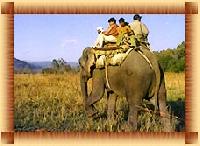
Elephant Safari
Elephant Safari in India: The lord of the jungle is indeed the elephant and not the tiger as many believe. Elephants in the wild call for more caution than any other animal. Elephants have figured in our mythology and have been a part of Indian life for three thousand years. Ganesha the elephant headed Hindu god is worshipped as a harbinger of good luck and prosperity. Elephants are a common sight on our roads and temples and as a source of power still find use in forestry operations. About Elephant Safari: Elephant safari helps the visitor to travel through such difficult terrains where even jeeps cannot venture. And why not, riding an elephant takes you back to the royal era, when only the kings use to ride on these majestic beasts, since nothing can even compare with the majesty of the Pachyderm. Equipped with a howdah, a large seat on which they would sit, complete with soft silk cushions, and with a ceremonial umbrella over the riders head, modern day elephant safaris may lack in comparison with the ones that use to be done by the kings, but are no less regal on that account. The elephant moves slowly and steadily, thats why this type of safari is ideal in and around the wild regions or within the vicinity of the wildlife sanctuaries, where riding the elephant can give you an easy excess for viewing the wildlife. More of all a elephant safari tour in the tropical wildlife sanctuaries of India gets you up, close and personal with these majestic animals. Elephant Safari Tips: Since elephant safari is an elaborate affair, and requires many attendants for the elephant as well, such safari camps too tend to be a more lavish, and make the best choice for the incentive groups who are promised to get a journey to remember.Just like the tours there are certain essentials you have to keep in mind for elephant safari trip too. The weather conditions can vary a lot, especially in a desertic or tropical climate you require a good backup of plenty of portable water to avoid dehydration as well as sun screen, goggles, and a first aid kit.Elephant Safari in India: Elephant Safaris In Himalayan Regions In the North and the North East India elephant safari makes the best option of exploring the wildlife sanctuaries and national parks, especially the ones that are located in the Himalayan region. If you have gone to some national parks of the state and ridden an elephant in search of a tiger, then you would be quite aware of the immense versatility of this majestic animal in negotiating the difficult Himalayan terrain that even a jeep will not traverse. Why not an elephant for a long ride, covering days? Well, in the Himalayan forest regions you can do it, especially in national parks such as Corbett in Uttaranchal and Kaziranga in Assam. Elephant Safari in Periyar Wildlife Sanctuary: Take a tour of the Periyar sanctuary on motor launches in search of wildlife and youd be surprised with what you see. Periyar Wildlife Sanctuary is the best elephant hub; any animal lover would love to check out. From the rooms of the forest rest houses provided by the Kerala forest department to the tourists within the vicinity Periyar, you can get a wide-screen view of the whole sanctuary.Elephant Safari Tours:Best of India: Duration: 14 Nights / 15 DaysDestinations: New Delhi - Corbett - Agra - Bharatpur - Ranthambhore - Jaipur - KazirangaGlory of India: Duration: 20 Nights / 21DaysDestinations: Kolkata - Kaziranga - Darjeeling - Gangtok - Varanasi - Khajuraho - Bandhavgarh - Agra - Ranthambhore - Jaipur - New DelhiIndian Wildlife: Duration: 09 Nights / 10DaysDestinations: New Delhi - Bandhavgarh - Kanha.
...more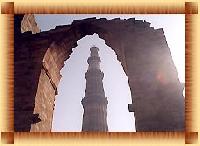
Delhi
Delhi has not always been the capital of India but it has played an important role in Indian history. It is said that history lives in Delhi, the capital of India. The city is actually is divided in two parts on is New Delhi & Old Delhi was the capital of Muslim India between 12th & 19th centuries. In old Delhi you will find many mosques, monuments & forts relating to Muslim history of India. The other Delhi is New Delhi, the imperial city created as the capital of India by the British. It is a spacious, open city & contains many embassies & government buildings. Red Fort : The red Fort dates from the very peak of Mogul power. This magnificent fort was built by Shah Jahan started construction of the massive fort in 1638 & it was completed in 1648. Aurangzeb was the first & last great Mogul emperor to rule from here. One can get a real still calm away from the city noise & confusion is light - years away from the fort gardens & pavilions. India Gate : The 42- meter- high arch of triumph stands at the eastern end of the Rajpath. It bears the name of 85000 Indian Army soldiers who died in the campaigns of World War First the North- west frontier operations of the same time & the 1919 Afghan fiasco. Jantar Mantar : Only a short stroll down Sansad Marg from Connaught place, this strange collection of salmon- colored structure is one of Maharaja Jai Singh IInd observatories. The ruler from Jaipur constructed this observatory in 1725 & it is dominated by a huge sundial known as the Prince of dials. Lakshmi Narayan Temple : Due west of Connaught Place, this garish mordent temple was erected by the Industrialist Birla in 1938. It is dedicated to Lakshmi, the goddess of prosperity & good fortune, & is commonly known as Birla Mandir.Connaught Place : At the northern end of New Delhi, Connaught Place is the business & tourist centre. It is a vast traffic circle with an architecturally uniform series of colonnaded buildings around the edge - mainly devoted to shops, airline offices & the like. Museum : On Jan path just south of Rajpath, the National Museum has a good collection of Indian bronzes, terracotta & wood sculptures dating back to the Mauryan period (2nd-3rd century BC ) & costume of the various tribal peoples. Other tombs include the later grave of Jaharanara, the daughter of Shah Jahan, who stayed with her father during the imprisonment by the Aurangzeb in Red Fort of Agra. Amir Khusru, a great Urdu poet, also has its tomb here as does Azam Khan, a favorite of Humayun & his son Akbar. Qutab Minar : The building in this complex, 15 km south of the onset of Muslim rule in India & are fine examples of Afghan architecture. The Qutab Minar itself is a soaring tower of victory which as started in 1193, immediately after the defeat of the last Hindu kingdom in Delhi. It is nearly 73 meters high & tapers from a 15- meter- diameter base to just 2.5 meters at the top. The tower has five distinct stories, each marked by a projecting balcony. First three stories are made of red sandstone, the forth & fifth of marble & sandstone. Helping Facts Airways : It has its own International airport ( INDRAGANDHI INTERNATIONAL AIRPORT). As well as Delhi also has its own domestic airport i.e. PALAN AIRPORT. Railways : Delhi is an important rail centre & an excellent place to make bookings. There is a special foreign tourist booking office upstairs in New Delhi station. Three major railway stations of Delhi daily has dozens of trains connecting the city with all the parts of the India. Road : The large Interstate bus station is at Kashmir Gate, north of the (Old) Delhi Railway Station. Facilities here includes 24-hour left luggage, State Bank of India branch, post office, pharmacy & Nagrik Restaurant of Delhi Transport. Climate : Summer is very hot & temperature can reach to 470C. The winter is pleasant & temperature can go down to 040C. Rainfall is 114 cm. And mostly in month of July & August. Further Connection : New Delhi is connected to the near about whole India. Tour to Delhi Best of IndiaDuration : 14 Nights / 15 DaysDestinations : New Delhi - Corbett - Agra - Bharatpur - Ranthambhore - Jaipur - KazirangaClassic India Duration : 13 Nights / 14 DaysDestinations : New Delhi - Agra - Ranthambhore - Jaipur - Deogarh - Udaipur - Jodhpur - SamodeColor of Rajasthan Duration : 13 Nights / 14 DaysDestinations : New Delhi - Agra - Jaipur - Pushkar - Mandawa - Bikaner (Gajner) - Jaisalmer - Jodhpur - UdaipurSeven Days for IndiaDuration : 06 Nights / 07 DaysDestinations : New Delhi - Agra - Jaipur
...more
currency
The big hotels, shops, restaurants and various Indian Airlines take major international credit cards. Travelers cheques are the safest form of money to be carried, and can be used directly to settle bills. Stick to the well known brands - American Express, Visa, Thomas Cook, Citibank and Barclays, keep the photocopies too. The best currencies to take are US dollars and pounds sterling. More than $10,000 (or equivalent) in cash, must be declared.There are also 24 hour branches of the State Bank of India and Thomas Cook in the arrival and departure areas of the international airport. The Indian currency is the rupee (Rs), which has 100 paisa. There are coins of 25, 50 paisa and also coins of Rs. 1, 2, 5. There are notes of Rs. 1, 2, 5, 10, 20, 50, 100, 500 and 1000. Check out current Exchange Rates. You will get encashment certificates from the Bank for each transaction, which should be kept carefully. In case, while going back you want the Indian Rupees to be changed back into foreign currency, the same can be done up to US $ 500 worth of rupees. Credit cards are widely accepted at mid range and up market hotels and for buying rail and air tickets and also in many shops. On a MasterCard, Visa Card, or Japanese Credit bureau card, you can now get cash advances in rupees on the spot in main cities. With American Express you can get dollar or sterling traveler�s cheques. TELEPHONEThere are private STD/ISD call booths everywhere with direct local, interstate and international dialing. A digital meter is attached to let you know, how much your call is costing and gives you a printout at the end. The international access code from India is 00, after which you need to dial your country code followed by area code and then the phone number. Almost all the hotel rooms have the facility for phones, but international calls have hefty additional charges levied.Fax facility are available on most of these STD/ISD call booths and also in the hotels.
...more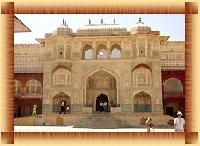
Colors of Rajasthan
Duration : 13 Nights 14 DaysDestinations : New Delhi - Agra - Jaipur - Pushkar - Mandawa - Bikaner (Gajner) - Jaisalmer - Jodhpur - UdaipurDay 01 : DelhiWelcome in India! On arrival you will be transferred and assisted till your room in your hotel. Remaining day at leisure. Day 02 : New DelhiAfter a leisurely breakfast move out for a daylong sightseeing of Old Delhi (Shahajahanabad), which includes the Red Fort, Chandni Chowk & Jama Masjid.Later after lunch drive past through impressive boulevards and buildings such as President’s Residence and others in Lutyen’s Delhi (New Delhi). Evening free to move around the busy Connaught Place. Day 03 : Agra Drive to Agra and check in at your hotel. After lunch visit the Taj Mahal and Agra Fort. Evening free to relax. Day 04 : JaipurAfter a leisurely breakfast drive to Jaipur in your exclusive vehicle. On arrival to the charming Pink City of India check in at your hotel. Further move out for a sightseeing tour that includes visit to City Palace, Jantar Mantar observatory, Hawa Mahal, Birla temple and Albert hall. In the evening take a walking tour of the colorful streets and bazaars of Jaipur City. The beauty of Jaipur is that its unique architecture and town planning is visible at even the most commonest places such as its squares and lanes. Day 05 : PushkarIn the morning move out to visit the Amber Fort. Here at Amber, you’ll ascend till the gates of majestic fort on elephant back. The fort displays a beautiful mix of Mughal and Rajput styles of architecture. Further driver to Pushkar in your xclusive vehicle. Rest of the free to explore on your on. Day 06 : PushkarAfter a leisurely breakfast move out to visit the holiest city of Rajasthan. Take a pleasant walk on the street around the sacred pond and Ghats up to Brahma temple. Entire day free to explore the spiritual facets of the town on own. Day 07 : MandawaIn the morning drive to Mandawa in your exclusive vehicleyou’re your arrival check in at your hotel. Relax for a while. Later move out for a walking tour of the town to see some of its frescoed havelies. Day 08 : Bikaner (Gajner)Reach to Gajner through Bikaner-the camel city. On arrival check in to your hotel. Rest of the day at leisure. Further visit the well-preserved Junagarh fort. In the evening visit the unique camel-breeding farm. Day 09 : JaisalmerDrive to Jaisalmer. Transfer on camels to desert camp in a village outside Jaisalmer to spend the day in rustic desert atmosphere. Night stay in desert camp. Day 10 : JaisalmerTransfer to Jaisalmer city and check in. Sightseeing of various attractions of the town including a walk in the fort and lanes of the town below. Day 11 : JodhpurDrive through desert landscape with brief halts at Kheechan (haven for migratory Demoiselle Cranes) and Osian village (ancient trading town famous for its superbly carved temples). At Jodhpur visit majestic Mehrangarh fort. Evening free at the old markets around Clock Tower. Day 12 : UdaipurMorning drive to Udaipur visiting the unparalleled Ranakpur temples (the temple here is the largest Jain temple in the world having 1444 carved pillars with no two pillars looking alike!) before finally checking in. On arrival, have some leisure in your idyllic room in the Lake Palace. The Lake Palace seems like floating on the calm waters of Lake Pichhola. In the evening take a sightseeing tour of the breathtaking royal buildings around the Lake in boat tour. Day 13 : DelhiDay sightseeing of City Palace, Saheliyon ki Bari, Eklingji and Nagda. Evening entertainment at Bharatiya Lok Kala Mandal. In the evening you will be transferred to the train station to board the flight for New Delhi. Over night at the train. Day 14 : DepartureOn arrival you will be received at the train station and you will be transferred straight to your hotel the tour ends.
...more
Transportation
Airport To Hotel - Delhi is a major international gateway to India, at times, the international flights out of Delhi can be heavily booked, therefore, it is advised to plan and book your tickets well in advance. Double check your reservations and reconfirm your flight.Taxi - Once you are through customs, you will find yourself surrounded by lot of porters offering to carry your bags or find you a taxi, choose one person finely. If you are being met by your hotel, they will make themselves known to you by carrying a board with your name on it. If not, the international airport operates a fixed - rate centralized taxi service for going into New Delhi. There are counters to guide you with maps and pre-paid taxi services. If this is your first trip to India, take down the registration number of the taxi and insist on going to the hotel of your choice only.Auto Rickshaw - An Auto Rickshaw is a three - wheeler vehicle, generally about half the price of a taxi.
...more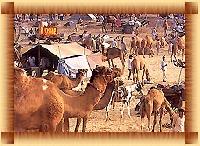
tour travel services
The mellow, quite & interesting little town of Pushkar is one of those travelers centers where people go for a little respite from hardships of life on the Indian road. It is only 11km away from Ajmer but separated from it by Nag Pahar (the snake mountain), & is situated right on the edge of the desert. The town clings to the small but beautiful Pushkar Lake with its many bathing ghats & temples. For Hindus, Pushkar is a very important pilgrimage centre. Unfortunately after a poor monsoon it does not get refilled & can be almost empty. This is a great pity, as it is a big factor in the appeal of town. Pushkar is also world famous for the huge camel & cattle fair which takes place here each October & November. At this time, the town is thronged with tribal people from all over Rajasthan, pilgrims from all over the India & film makers & tourist from all over the world. Camel Fair : The exact date on which the Camel Fare is held depends on the lunar calendar but, in Hindu chronology, it full moon of Kartik Purnima. Each year, up to 200,000 people flock to Pushkar for the Camel Fare , bringing with them some 50,000 camels & cattle for the Camel Fare, bringing with them some 50,000 camels & cattle for several days of pilgrimage, horses dealing, camel racing & colorful festivities. It is one of the biggest & most colorful festivals. Temples : Pushkar boasts temples, through few are as ancient as ancient as you might except at such an important pilgrimage site since many were destroyed by Aurangzeb & subsequently rebuilt. The most famous is what is said to be the only temple in India dedicated to Brahma. It is marked by a red spire, & over the entrance gateway is the hans, or goose symbol, of Brahma, who is said to have personally chosen Pushkar as its site. Ghats : Numerous ghats run down to the lake, & pilgrims are constantly bathing in the holy waters of lake. If you wish to join them, do it with respect - remove your shoes, do not smoke & do not take photographs. The pilgrims here can be very touchy about insensitive intrusions by non - Hindus. Helping Facts Airways : Pushkar do not have its own airport, the nearest airport from Pushkar is the Jaipur airport which is148 km away. Railways : Ajmer is the nearest railway station from Pushkar. Ajmer is on the Delhi / Marwar / Ahamedabad / Jaipur line & most trains on this line stop at Ajmer. Roadways : In every hour there are 2 or 3 buses for Ajmer and from there you can move to any place of your choice. Climate : In the summer it is much hot & in the winter it is quite pleasant Further Connections : Ajmer, Jaipur, Deogarh, Udaipur and Jodhpur. Tour to Pushkar Color of Rajasthan Duration : 13 Nights / 14 DaysDestinations : New Delhi - Agra - Jaipur - Pushkar - Mandawa - Bikaner (Gajner) - Jaisalmer - Jodhpur - Udaipur
...more
Travel Agent

Indian Wildlife Tour Packages

North India Tour

domestic tours
Be first to Rate
Rate This